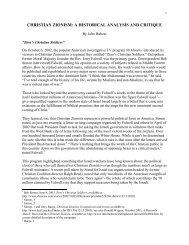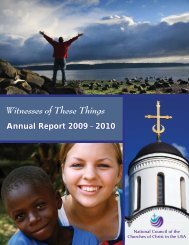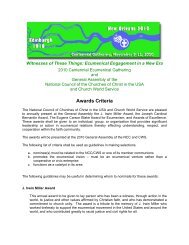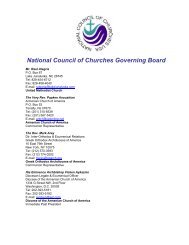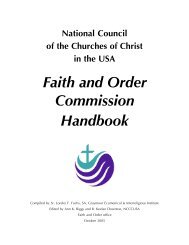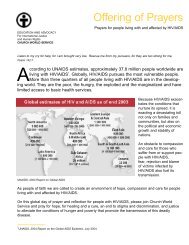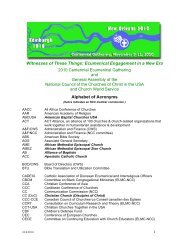Common Agreement on Mutual Recognition of Baptism - National ...
Common Agreement on Mutual Recognition of Baptism - National ...
Common Agreement on Mutual Recognition of Baptism - National ...
You also want an ePaper? Increase the reach of your titles
YUMPU automatically turns print PDFs into web optimized ePapers that Google loves.
1150<br />
1151<br />
1152<br />
1153<br />
1154<br />
1155<br />
1156<br />
1157<br />
1158<br />
1159<br />
1160<br />
1161<br />
1162<br />
1163<br />
1164<br />
1165<br />
1166<br />
1167<br />
1168<br />
1169<br />
1170<br />
1171<br />
1172<br />
1173<br />
1174<br />
1175<br />
1176<br />
1177<br />
1178<br />
1179<br />
1180<br />
1181<br />
1182<br />
1183<br />
1184<br />
1185<br />
1186<br />
1187<br />
1188<br />
1189<br />
1190<br />
1191<br />
1192<br />
1193<br />
1194<br />
<strong>on</strong> biblical and patristic texts and rites as a point <strong>of</strong> departure for ritual reforms. As it turned out,<br />
however, both Churches were poised to look at the same sources but in answer to different<br />
questi<strong>on</strong>s, with different points <strong>of</strong> departure, theological hermeneutics and methods. As a result,<br />
the emergence <strong>of</strong> baptismal rites which share many comm<strong>on</strong> features in both communities,<br />
n<strong>on</strong>etheless appear to reflect differing theological understandings, thus raising the questi<strong>on</strong> <strong>of</strong> the<br />
extent to which theological divergences need further explorati<strong>on</strong>.<br />
4 f. 20 th century c<strong>on</strong>vergence in scholarship and ritual structures:<br />
i. Reformed<br />
In 1957, two streams <strong>of</strong> the Reformed church family, the C<strong>on</strong>gregati<strong>on</strong>al Christian<br />
Churches and the Evangelical and Reformed Church, came together to form the United Church<br />
<strong>of</strong> Christ (UCC). This new church, bringing together both New England C<strong>on</strong>gregati<strong>on</strong>alism with<br />
its Puritan heritage and German Reformed Protestantism with its Pietist heritage, has been<br />
ecumenically oriented from the beginning. Though c<strong>on</strong>gregati<strong>on</strong>s are free to shape liturgical<br />
forms at the local level, the UCC as a denominati<strong>on</strong> has attended closely to the ecumenical<br />
biblical and historical scholarship that led to the liturgical renewal movement <strong>of</strong> the 1960s and<br />
1970s. This ecumenical commitment significantly shaped the order <strong>of</strong> baptism found in the 1986<br />
Book <strong>of</strong> Worship. In fact, the Order <strong>of</strong> <strong>Baptism</strong> ―rests significantly <strong>on</strong> an ecumenical liturgical<br />
c<strong>on</strong>sensus found in the 1982 <strong>Baptism</strong>, Eucharist, and Ministry (BEM) document more than <strong>on</strong><br />
any <strong>on</strong>e former traditi<strong>on</strong>.‖ xxii Though not required for use, this 1986 liturgical resource reflects<br />
Reformed baptismal themes that have been central since the 16 th century: c<strong>on</strong>necti<strong>on</strong> <strong>of</strong> baptism<br />
with proclamati<strong>on</strong> <strong>of</strong> the Word; focus <strong>on</strong> water as the central symbol <strong>of</strong> baptism xxiii ; ecclesial<br />
setting <strong>of</strong> baptism; and c<strong>on</strong>necti<strong>on</strong> <strong>of</strong> baptism with <strong>on</strong>going nurture, signified by c<strong>on</strong>gregati<strong>on</strong>al<br />
promises and the opti<strong>on</strong> <strong>of</strong> including baptismal sp<strong>on</strong>sors in the service.<br />
In the 1960s, both the CRCNA and the RCA moved to revise their rites more<br />
substantially than they had d<strong>on</strong>e ever before. The RCA in 1968 adopted revised rites after<br />
several years <strong>of</strong> drafting and evaluati<strong>on</strong> <strong>of</strong> provisi<strong>on</strong>al orders. xxiv The CRC, a few years later in<br />
1976, adopted a similar revised order. xxv Both revised orders reflect similar c<strong>on</strong>cerns: to state<br />
more clearly the biblical instituti<strong>on</strong> for baptism, to present more clearly the covenantal basis for<br />
baptism, and to make more explicit the c<strong>on</strong>gregati<strong>on</strong>‘s resp<strong>on</strong>sibility to nurture baptized<br />
children. xxvi<br />
Though the RCA published another alternate order for baptism in Worship the Lord in<br />
1987, the next major revisi<strong>on</strong> <strong>of</strong> the baptismal forms came in 1994, for both the RCA and the<br />
CRC. It is significant that in both cases, there is a single form or outline provided, which can be<br />
used for either infant or adult baptism. There are no l<strong>on</strong>ger two separate rites. xxvii This is<br />
particularly striking, since the Roman Catholic revisi<strong>on</strong>s <strong>of</strong> this era went in the opposite<br />
directi<strong>on</strong>, clarifying two different orders for infant and adult baptism. The CRC form is<br />
explicitly intended to be more flexible, permitting local adaptati<strong>on</strong>. Both <strong>of</strong> these recent<br />
baptismal orders reflect awareness <strong>of</strong> the ecumenical liturgical movement, with greater attenti<strong>on</strong><br />
to the symbolic value <strong>of</strong> water and inclusi<strong>on</strong> <strong>of</strong> ancient elements such as renunciati<strong>on</strong>s,<br />
affirmati<strong>on</strong>s, and a prayer <strong>of</strong> thanksgiving over the water. At the same time, these new rites<br />
show c<strong>on</strong>tinuing Reformed sensibilities in their opening words <strong>of</strong> instituti<strong>on</strong>, their emphasis <strong>on</strong><br />
covenant, and the inclusi<strong>on</strong> <strong>of</strong> promises by both parents/baptizands and c<strong>on</strong>gregati<strong>on</strong> to nurture<br />
30



